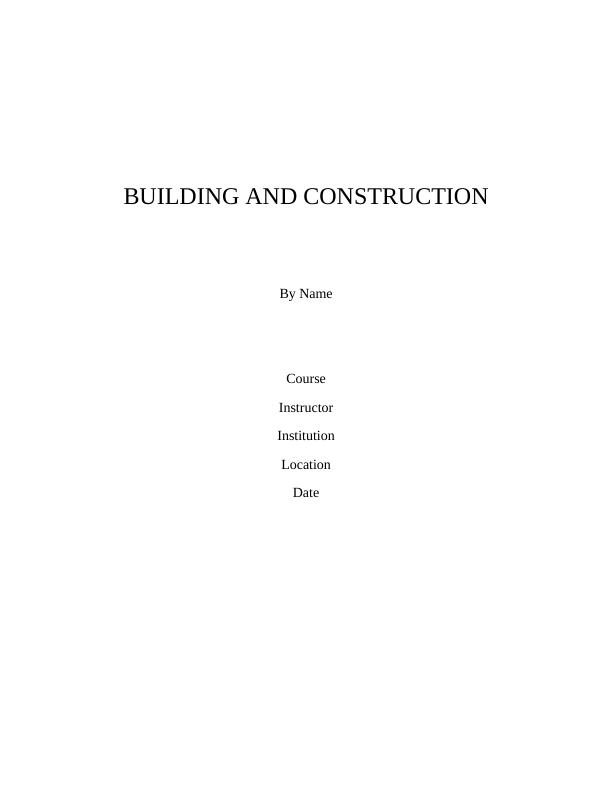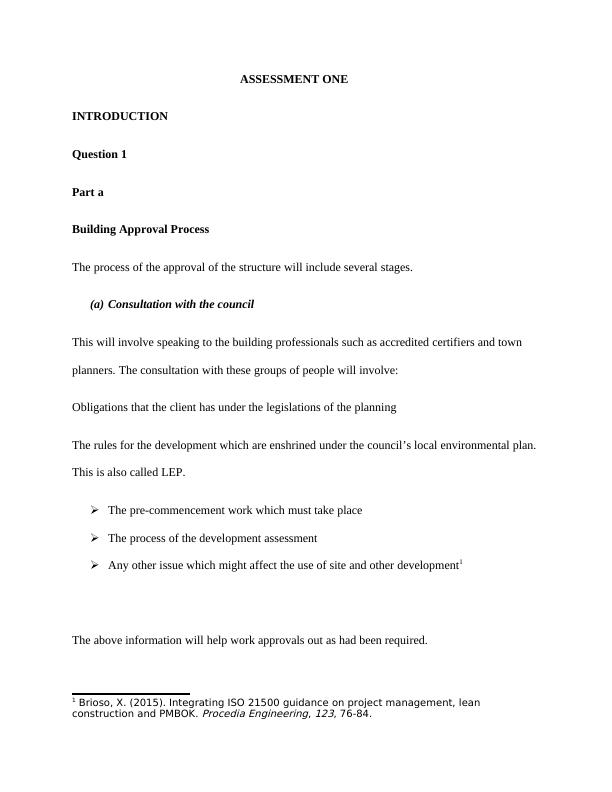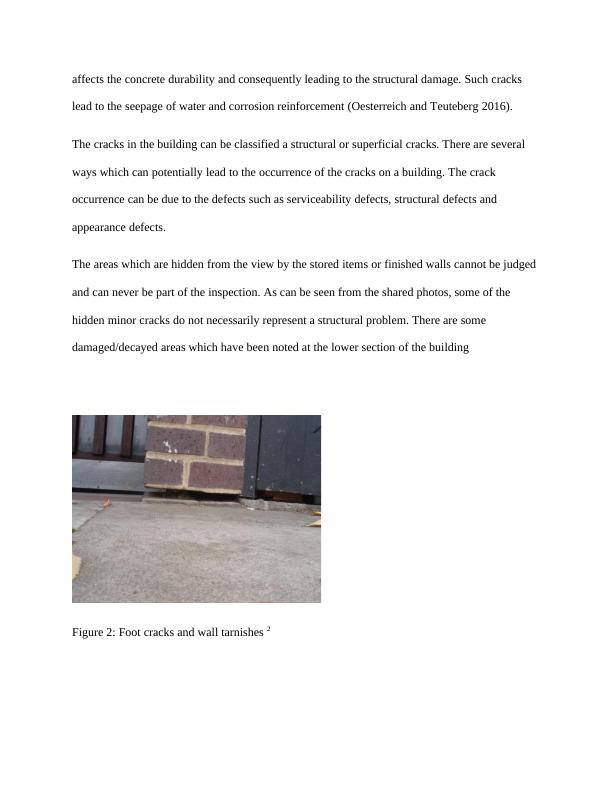Building Approval Process: Stages and Requirements
Added on 2022-12-12
21 Pages2852 Words115 Views
BUILDING AND CONSTRUCTION
By Name
Course
Instructor
Institution
Location
Date
By Name
Course
Instructor
Institution
Location
Date

ASSESSMENT ONE
INTRODUCTION
Question 1
Part a
Building Approval Process
The process of the approval of the structure will include several stages.
(a) Consultation with the council
This will involve speaking to the building professionals such as accredited certifiers and town
planners. The consultation with these groups of people will involve:
Obligations that the client has under the legislations of the planning
The rules for the development which are enshrined under the council’s local environmental plan.
This is also called LEP.
The pre-commencement work which must take place
The process of the development assessment
Any other issue which might affect the use of site and other development1
The above information will help work approvals out as had been required.
1 Brioso, X. (2015). Integrating ISO 21500 guidance on project management, lean
construction and PMBOK.
Procedia Engineering,
123, 76-84.
INTRODUCTION
Question 1
Part a
Building Approval Process
The process of the approval of the structure will include several stages.
(a) Consultation with the council
This will involve speaking to the building professionals such as accredited certifiers and town
planners. The consultation with these groups of people will involve:
Obligations that the client has under the legislations of the planning
The rules for the development which are enshrined under the council’s local environmental plan.
This is also called LEP.
The pre-commencement work which must take place
The process of the development assessment
Any other issue which might affect the use of site and other development1
The above information will help work approvals out as had been required.
1 Brioso, X. (2015). Integrating ISO 21500 guidance on project management, lean
construction and PMBOK.
Procedia Engineering,
123, 76-84.

Figure 1: Schematic illustration of the building approval process1
Applications for development certificate or what is commonly refered to as development
certificate.
(b) Development Applications (DA)
The building professionals or Council which may include accredited certifier or town planner
will be required to advice accordingly if there will be need for lodging of DA.
(C] Complying Development Certificate
Applications for development certificate or what is commonly refered to as development
certificate.
(b) Development Applications (DA)
The building professionals or Council which may include accredited certifier or town planner
will be required to advice accordingly if there will be need for lodging of DA.
(C] Complying Development Certificate

This is also refered to as CDC. It is regarded as an alternative to DA and its availability is meant
for the routine work. This certificate will be issued in case the proposed development complies
effectively with the relevant control of planning under the Building Code Australia.2
[d] Applications for the Certificate of the Construction
A certificate of construction will simply confirm the plans of the buildings comply with the
certificate of 3the development. This certificate must be obtained prior to the commencement of
the building works.
[e] Appointment of the principal Certifying Authority
The Principal Certifying Authority is the only person allowed to issue final certificate of
occupations
Finding out more about inspections
At least two days prior to the commencement of the work, it will be the primary responsibility of
the PCA to inform the client on the required inspections. It is from this point that the builder will
coordinate with the PCA on the mechanism of carrying out inspection exercise (Le, Pedro and
Park 2015).
[f] Obtaining the Occupation Certificate
2 Dave, B., Kubler, S., Främling, K., & Koskela, L. (2016). Opportunities for enhanced lean construction management
using Internet of Things standards.
Automation in construction,
61, 86-97.
3 Hwang, B. G., & Ng, W. J. (2013). Project management knowledge and skills for green
construction: Overcoming challenges.
International Journal of Project Management,
31(2),
272-284.
for the routine work. This certificate will be issued in case the proposed development complies
effectively with the relevant control of planning under the Building Code Australia.2
[d] Applications for the Certificate of the Construction
A certificate of construction will simply confirm the plans of the buildings comply with the
certificate of 3the development. This certificate must be obtained prior to the commencement of
the building works.
[e] Appointment of the principal Certifying Authority
The Principal Certifying Authority is the only person allowed to issue final certificate of
occupations
Finding out more about inspections
At least two days prior to the commencement of the work, it will be the primary responsibility of
the PCA to inform the client on the required inspections. It is from this point that the builder will
coordinate with the PCA on the mechanism of carrying out inspection exercise (Le, Pedro and
Park 2015).
[f] Obtaining the Occupation Certificate
2 Dave, B., Kubler, S., Främling, K., & Koskela, L. (2016). Opportunities for enhanced lean construction management
using Internet of Things standards.
Automation in construction,
61, 86-97.
3 Hwang, B. G., & Ng, W. J. (2013). Project management knowledge and skills for green
construction: Overcoming challenges.
International Journal of Project Management,
31(2),
272-284.

Prior to the occupation of the building, the client must apply and obtain a certificate of the
occupation from the respective PCA. It will be upon the PCA to carry out an exercise of
inspection so as to approve whether the building is suitable for occupation. In case there is
unreasonable delay of the release of the approval by the PCA, the discussion should be launched
on the same with the PCA. In case there is no understanding, the matter can be escalated further
to the Board for further assistance and advice (Manca, Brambilla and Colombo 2013).
Types of the building approvals
The proposals which have been classified as “exempt development” usually do not
require approvals.
Development approvals: Although once it is given out there will be no need for the
compliance with the specific codes.
Part b
Differences between private and public approvals of the buildings
The local authority is usually regarded as the non-profit making organizations. This implies that
the charges are likely to be lower than those levied by the private sectors. Payment to the private
sector is expected to be more in case the client decides to get a dedicated inspector of the project
(Park et al 2013).
Question 2
Concrete is considered to be the most common material for building. The biggest disadvantages
of concrete is that it can crack easily crack. This affects the durability of the concrete and further
occupation from the respective PCA. It will be upon the PCA to carry out an exercise of
inspection so as to approve whether the building is suitable for occupation. In case there is
unreasonable delay of the release of the approval by the PCA, the discussion should be launched
on the same with the PCA. In case there is no understanding, the matter can be escalated further
to the Board for further assistance and advice (Manca, Brambilla and Colombo 2013).
Types of the building approvals
The proposals which have been classified as “exempt development” usually do not
require approvals.
Development approvals: Although once it is given out there will be no need for the
compliance with the specific codes.
Part b
Differences between private and public approvals of the buildings
The local authority is usually regarded as the non-profit making organizations. This implies that
the charges are likely to be lower than those levied by the private sectors. Payment to the private
sector is expected to be more in case the client decides to get a dedicated inspector of the project
(Park et al 2013).
Question 2
Concrete is considered to be the most common material for building. The biggest disadvantages
of concrete is that it can crack easily crack. This affects the durability of the concrete and further

affects the concrete durability and consequently leading to the structural damage. Such cracks
lead to the seepage of water and corrosion reinforcement (Oesterreich and Teuteberg 2016).
The cracks in the building can be classified a structural or superficial cracks. There are several
ways which can potentially lead to the occurrence of the cracks on a building. The crack
occurrence can be due to the defects such as serviceability defects, structural defects and
appearance defects.
The areas which are hidden from the view by the stored items or finished walls cannot be judged
and can never be part of the inspection. As can be seen from the shared photos, some of the
hidden minor cracks do not necessarily represent a structural problem. There are some
damaged/decayed areas which have been noted at the lower section of the building
Figure 2: Foot cracks and wall tarnishes 2
lead to the seepage of water and corrosion reinforcement (Oesterreich and Teuteberg 2016).
The cracks in the building can be classified a structural or superficial cracks. There are several
ways which can potentially lead to the occurrence of the cracks on a building. The crack
occurrence can be due to the defects such as serviceability defects, structural defects and
appearance defects.
The areas which are hidden from the view by the stored items or finished walls cannot be judged
and can never be part of the inspection. As can be seen from the shared photos, some of the
hidden minor cracks do not necessarily represent a structural problem. There are some
damaged/decayed areas which have been noted at the lower section of the building
Figure 2: Foot cracks and wall tarnishes 2

End of preview
Want to access all the pages? Upload your documents or become a member.
Related Documents
CPCCBC4007A Plan building or construction worklg...
|13
|2528
|91
Roles in Construction Industry Project 2022lg...
|6
|1385
|13
Plan Building and Construction Work - Research Paperlg...
|10
|1799
|356
Construction: Council and Site Constraints for Strategic Planninglg...
|12
|2666
|95
